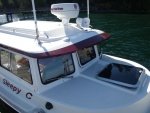hardee
New member
- Joined
- Oct 30, 2006
- Messages
- 12,637
- Reaction score
- 2
- C Dory Year
- 2005
- C Dory Model
- 22 Cruiser
- Hull Identification Number
- Brat # 2202
- Vessel Name
- Sleepy-C
Great article, and info. I have seen some of the Morad antennas around. They will be what I replace my Shakeys with if/when that happens. My 8ft glass is a Commrod and it has tested and performed well. I am a firm believer in having good antennas to get out (and in) good radio performance.
Harvey
SleepyC :moon

Harvey
SleepyC :moon


